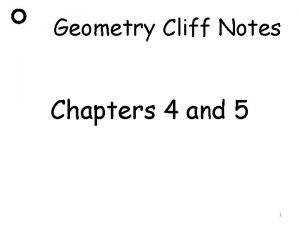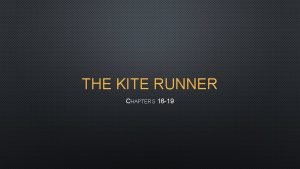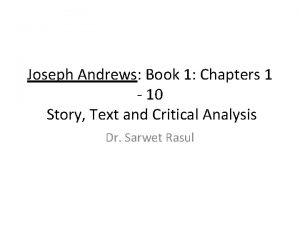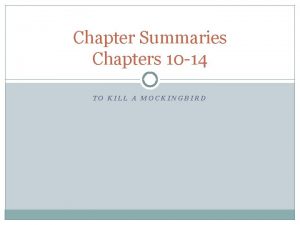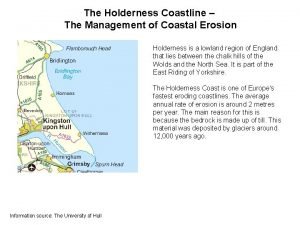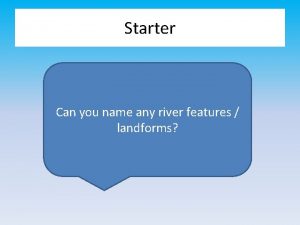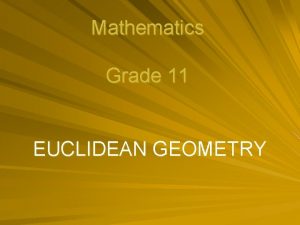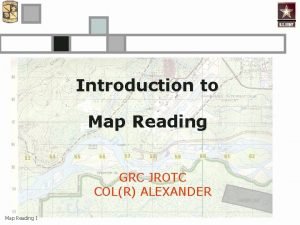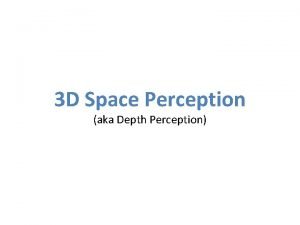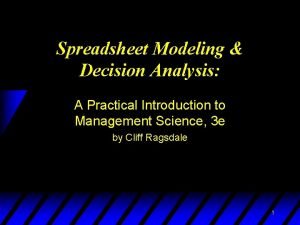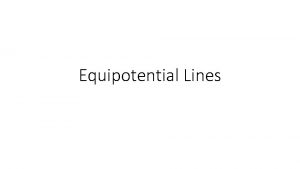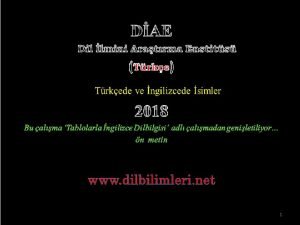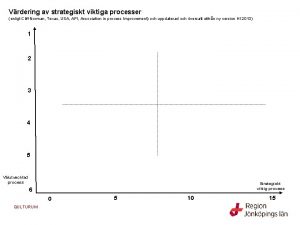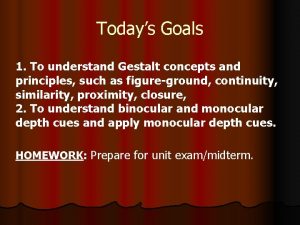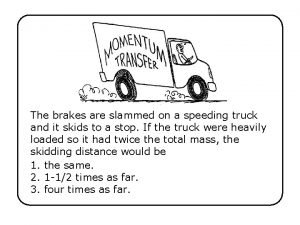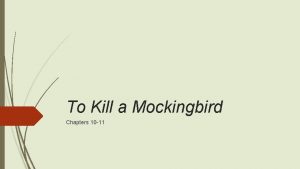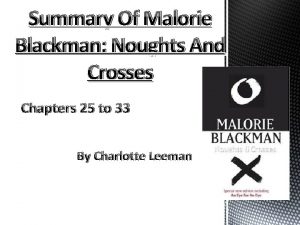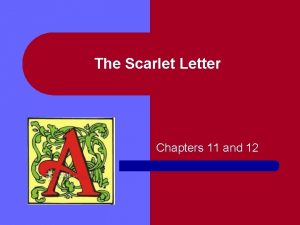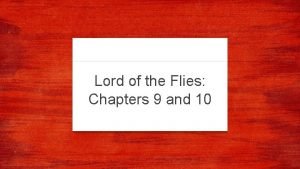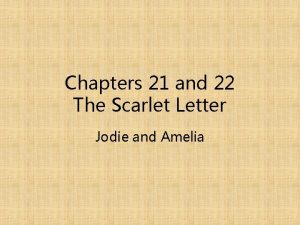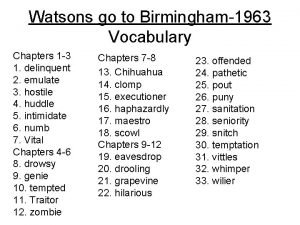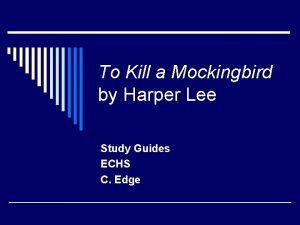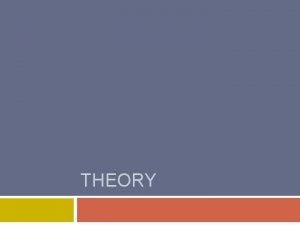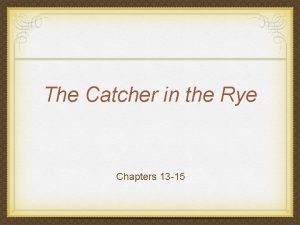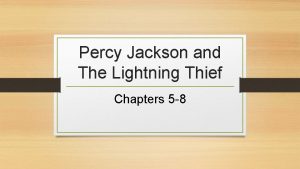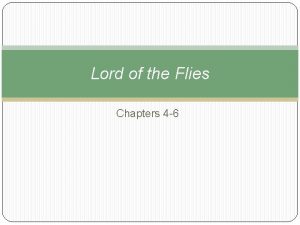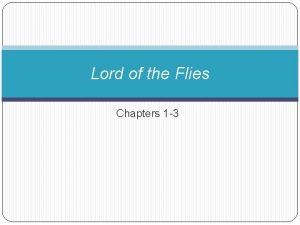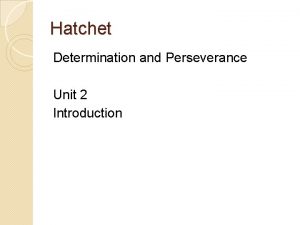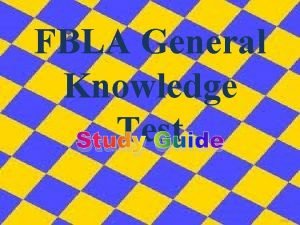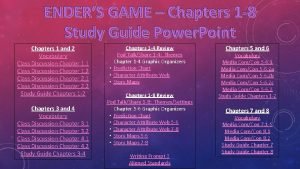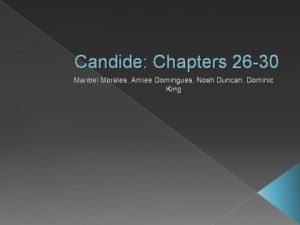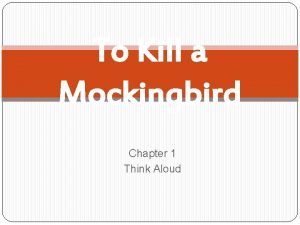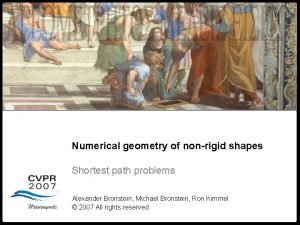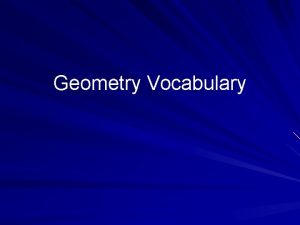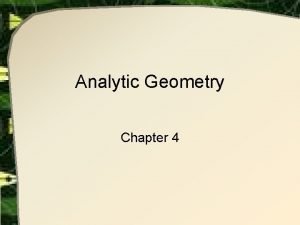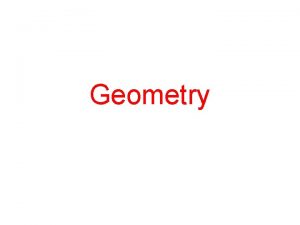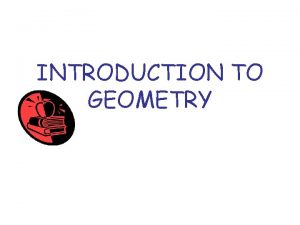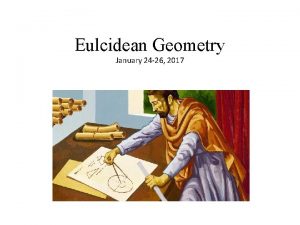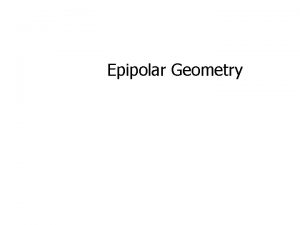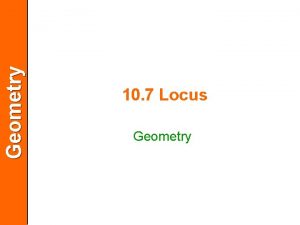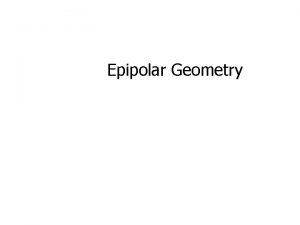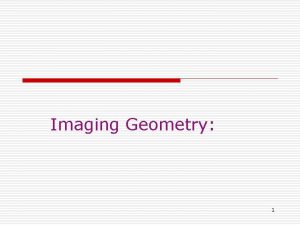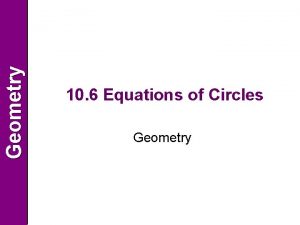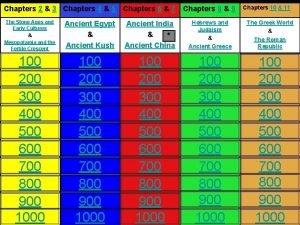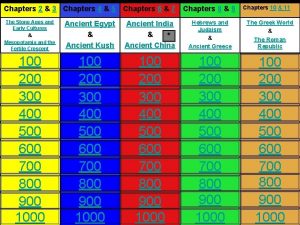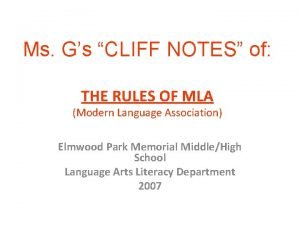Geometry Cliff Notes Chapters 4 and 5 1

























































































































- Slides: 121

Geometry Cliff Notes Chapters 4 and 5 1

Chapter 4 Reasoning and Proof, Lines, and Congruent Triangles 2

Distance Formula d= Example: Find the distance between (3, 8)(5, 2) d= 3

Midpoint Formula M= Example: Find the midpoint (20, 5)(30, -5) M= 4

Conjecture An unproven statement that is based on observations. 5

Inductive Reasoning Used when you find a pattern in specific cases and then write a conjecture for the general case. 6

Counterexample A specific case for which a conjecture is false. Conjecture: All odd numbers are prime. Counterexample: The number 9 is odd but it is a composite number, not a prime number. 7

Conditional Statement A logical statement that has two parts, a hypothesis and a conclusion. Example: All sharks have a boneless skeleton. Hypothesis: All sharks Conclusion: A boneless skeleton 8

If-Then Form A conditional statement rewritten. “If” part contains the hypothesis and the “then” part contains the conclusion. Original: All sharks have a boneless skeleton. If-then: If a fish is a shark, then it has a boneless skeleton. ** When you rewrite in if-then form, you may need to reword the hypothesis and conclusion. ** 9

Negation Opposite of the original statement. Original: All sharks have a boneless skeleton. Negation: Sharks do not have a boneless skeleton. 10

Converse To write a converse, switch the hypothesis and conclusion of the conditional statement. Original: Basketball players are athletes. If-then: If you are a basketball player, then you are an athlete. Converse: If you are an athlete, then you are a basketball player. 11

Inverse To write the inverse, negate both the hypothesis and conclusion. Original: Basketball players are athletes. If-then: If you are a basketball player, then you are an athlete. (True) Converse: If you are an athlete, then you are a basketball player. (False) Inverse: If you are not a basketball player, then you 12 are not an athlete. (False)

Contrapositive To write the contrapositive, first write the converse and then negate both the hypothesis and conclusion. Original: Basketball players are athletes. If-then: If you are a basketball player, then you are an athlete. (True) Converse: If you are an athlete, then you are a basketball player. (False) Inverse: If you are not a basketball player, then you are not an athlete. (False) Contrapositive: If you are not an athlete, then you are not a 13 basketball player. (True)

Equivalent Statement When two statements are both true or both false. 14

Perpendicular Lines Two lines that intersect to form a right angle. Symbol: 15

Biconditional Statement When a statement and its converse are both true, you can write them as a single biconditional statement. A statement that contains the phrase “if and only if”. Original: If a polygon is equilateral, then all of its sides are congruent. Converse: If all of the sides are congruent, then it is an equilateral polygon. Biconditional Statement: A polygon is equilateral if and only if all of its sides are congruent. 16

Deductive Reasoning Uses facts, definitions, accepted properties, and the laws of logic to form a logical statement. 17

Law of Detachment If the hypothesis of a true conditional statement is true, then the conclusion is also true. Original: If an angle measures less than 90°, then it is not obtuse. m <ABC = 80° <ABC is not obtuse 18

Law of Syllogism If hypothesis p, then conclusion q. If hypothesis q, then conclusion r. (If both statements above are true). If hypothesis p, then conclusion r Original: If the power is off, then the fridge does not run. If the fridge does not run, then the food will spoil. Conditional Statement: If the power if off, then the 19 food will spoil.

Postulate A rule that is accepted without proof. 20

Theorem A statement that can be proven. 21

Subtraction Property of Equality Subtract a value from both sides of an equation. x +7 = 10 -7 -7 X=3 22

Addition Property of Equality Add a value to both sides of an equation. X-7 = 10 +7 +7 X = 17 23

Division Property of Equality Divide both sides by a value. 3 x = 9 3 3 x=3 24

Multiplication Property of Equality Multiply both sides by a value. ½x = 7 · 2 x = 14 25

Distributive Property To multiply out the parts of an expression. 2(x-7) 2 x - 14 26

Substitution Property of Equality Replacing one expression with an equivalent expression. AB = 12, CD = 12 AB= CD 27

Proof Logical argument that shows a statement is true. 28

Two-column Proof Numbered statements and corresponding reasons that show an argument in a logical order. # Statement Reason 1 3(2 x-3)+1 = 2 x Given 2 6 x - 9 + 1 = 2 x Distributive Property 3 4 x - 9 + 1 = 0 Subtraction Property of Equality 4 4 x - 8 = 0 Add/Simplify 5 4 x = 8 Addition Property of Equality 6 x=2 Division Property of Equality 29

Reflexive Property of Equality Segment: For any segment AB, AB AB or AB = AB Angle: For any angle or 30

Symmetric Property of Equality Segment: If AB CD then CD AB or AB = CD Angle: 31

Transitive Property of Equality Segment: If AB CD and CD EF, then AB EF or AB=EF Angle: 32

Supplementary Angles Two Angles are Supplementary if they add up to 180 degrees. 33

Complementary Angles Two Angles are Complementary if they add up to 90 degrees (a Right Angle). 34

Segment Addition Postulate If B is between A and C, then AB + BC = AC. If AB + BC = AC, then B is between A and C. . A . B . C 35

Angle Addition Postulate If S is in the interior of angle PQR, then the measure of angle PQR is equal to the sum of the measures of angle PQS and angle SQR. 36

Right Angles Congruence Theorem All right angles are congruent. 37

Vertical Angles Congruence Theorem Vertical angles are congruent. 38

Linear Pair Postulate Two adjacent angles whose common sides are opposite rays. If two angles form a linear pair, then they are supplementary. 39

Theorem 4. 7 If two lines intersect to form a linear pair of congruent angles, then the lines are perpendicular. 40

Theorem 4. 8 If two lines are perpendicular, then they intersect to form four right angles. 41

Theorem 4. 9 If two sides of two adjacent acute angles are perpendicular, then the angles are complementary. 42

Transversal A line that intersects two or more coplanar lines at different points. 43

Theorem 4. 10 Perpendicular Transversal Theorem If a transversal is perpendicular to one of two parallel lines, then it is perpendicular to the other. 44

Theorem 4. 11 Lines Perpendicular to a Transversal Theorem In a plane, if two lines are perpendicular to the same line, then they are parallel to each other. 45

Distance from a point to a line The length of the perpendicular segment from the point to the line. • Find the slope of the line • Use the negative reciprocal slope starting at the given point until you hit the line • Use that intersecting point as your second point. • Use the distance formula 46

Congruent Figures All the parts of one figure are congruent to the corresponding parts of another figure. (Same size, same shape) 47

Corresponding Parts The angles, sides, and vertices that are in the same location in congruent figures. 48

Coordinate Proof Involves placing geometric figures in a coordinate plane. 49

Side-Side Congruence Postulate (SSS) If three sides of one triangle are congruent to three sides of a second triangle, then the two triangles are congruent. 50

Legs In a right triangle, the sides adjacent to the right angle are called the legs. (a and b) 51

Hypotenuse The side opposite the right angle. (c) 52

Side-Angle-Side Congruence Postulate (SAS) If two sides and the included angle of one triangle are congruent to two sides and the included angle of a second triangle, then the two triangles are congruent. 53

Theorem 4. 12 Hypotenuse-Leg Congruence Theorem If the hypotenuse and a leg of a right triangle are congruent to the hypotenuse and a leg of a second triangle, then the two triangles are congruent. 54

Flow Proof Uses arrows to show the flow of a logical statement. 55

Angle-Side-Angle Congruence Postulate (ASA) If two angles and the included side of one triangle are congruent to two angles and the included side of a second triangle, then the two triangles are congruent. 56

Theorem 4. 13 Angle-Side Congruence Theorem If two angles and a non-included side of one triangle are congruent to two angles and the corresponding non-included side of a second triangle, then the two triangles are congruent. 57

Chapter 5 Relationships in Triangles and Quadrilaterals 58

Midsegment of a Triangle Segment that connects the midpoints of two sides of the triangle. 59

Theorem 5. 1 Midsegment Theorem The segment connecting the midpoints of two sides of a triangle is parallel to the third side and is half as long as that side. x=3 60

Perpendicular Bisector A segment, ray, line, or plane that is perpendicular to a segment at its midpoint. 61

Equidistant A point is the same distance from each of two figures. 62

Theorem 5. 2 Perpendicular Bisector Theorem: In a plane, if a point is on the perpendicular bisector of a segment, then it is equidistant from the endpoints of the segment. 63

Theorem 5. 3 Converse of the Perpendicular Bisector Theorem In a plane, if a point is equidistant from the endpoints of a segment, then it is on the perpendicular bisector of the segment. 64

Concurrent When three or more lines, rays, or segments intersect in the same point. 65

Theorem 5. 4 Concurrency of Perpendicular Bisectors of a Triangle The perpendicular bisectors of a triangle intersect at a point that is equidistant from the vertices of the triangle. 66

Circumcenter The point of concurrency of the three perpendicular bisectors of a triangle. 67

Angle Bisector A ray that divides an angle into two congruent adjacent angles. 68

Incenter Point of concurrency of the three angle bisectors of a triangle. 69

Theorem 5. 5 Angle Bisector Theorem If a point is on the bisector of an angle, then it is equidistant from the two sides of the angle. 70

Theorem 5. 7 Concurrency of Angle Bisectors of a Triangle The angle bisectors of a triangle intersect at a point that is equidistant from the sides of the triangle. 71

Theorem 5. 6 Converse of the Angle Bisector Theorem If a point is in the interior of an angle and is equidistant from the sides of the angle, then it lies on the bisector of the angle. 72

Median of a Triangle Segment from a vertex to the midpoint of the opposite side. 73

Centroid Point of concurrency of the three medians of a triangle. Always on the inside of the triangle. 74

Altitude of a Triangle Perpendicular segment from a vertex to the opposite side or to the line that contains the opposite side. 75

Orthocenter Point at which the lines containing the three altitudes of a triangle intersect. 76

Theorem 5. 8 Concurrency of Medians of a Triangle The medians of a triangle intersect at a point that is two thirds of the distance from each vertex to the midpoint of the opposite side. 77

Theorem 5. 9 Concurrency of Altitudes of a Triangle The lines containing the altitudes of a triangle are concurrent. 78

Theorem 5. 10 If one side of a triangle is longer than another side, then the angle opposite the longer side is larger than the angle opposite the shorter side. 79

Theorem 5. 11 If one angle of a triangle is larger than another angle, then the side opposite the larger angle is longer than the side opposite the smaller angle. 80

Theorem 5. 12 Triangle Inequality Theorem The sum of the lengths of the two smaller sides of a triangle must be greater than the length of the third side. 81

Theorem 5. 13 Exterior Angle Inequality Theorem The measure of an exterior angle of a triangle is greater than the measure of either of the nonadjacent interior angles. 82

Theorem 5. 14 Hinge. Theorem If two sides of one triangle are congruent to two sides of another triangle, and the included angle of the first is larger than the included angle of the second, then the third side of the first is longer than the third side of the second. 11 cm 72 68 83

Theorem 5. 15 Converse of the Hinge. Theorem If two sides of one triangle are congruent to two sides of another triangle, and the third side of the first is longer than the third side of the second, then the included angle of the first is longer than the third side of the second. 11 cm 72 68 84

Indirect Proof A proof in which you prove that a statement is true by first assuming that its opposite is true. If this assumption leads to an impossibility, then you have proved that the original statement is true. Example: Prove a triangle cannot have 2 right angles. 1) Given ΔABC. 2) Assume angle A and angle B are both right angles is true by one of two possibilities (it is either true or false so we assume it is true). 3) measure of angle A = 90 degrees and measure of angle B = 90 degrees by definition of right angles. 4) measure of angle A + measure of angle B + measure of angle C = 180 degrees by the sum of the angles of a triangle is 180 degrees. 5) 90 + measure of angle C = 180 by substitution. 6) measure of angle C = 0 degrees by subtraction postulate 7) angle A and angle B are both right angles is false by contradiction (an angle of a triangle cannot equal zero degrees) 8) A triangle cannot have 2 right angles by elimination (we showed since that if they were both right angles, the third angle would be zero degrees and this is a contradiction so therefore our assumption was false ). 85

Diagonal of a Polygon Segment that joins two nonconsecutive vertices. 86

Theorem 5. 16 Polygon Interior Angles Theorem The sum of the measures of the interior angles of a polygon is 180(n-2). n= number of sides 87

Corollary to Theorem 5. 16 Interior Angles of a Quadrilateral The sum of the measures of the interior angles of a quadrilateral is 360°. 88

Theorem 5. 17 Polygon Exterior Angles Theorem The sum of the measures of the exterior angles of a convex polygon, one angle at each vertex, is 360°. 89

Interior Angles of the Polygon Original angles of a polygon. In a regular polygon, the interior angles are congruent. 90

Exterior Angles of the Polygon Angles that are adjacent to the interior angles of a polygon. 91

Parallelogram A quadrilateral with both pairs of opposite sides parallel. 92

Theorem 5. 18 If a quadrilateral is a parallelogram, then its opposite sides are congruent. 93

Theorem 5. 19 If a quadrilateral is a parallelogram, then its opposite angles are congruent. 94

Theorem 5. 20 If a quadrilateral is a parallelogram, then its consecutive angles are supplementary. 95

Theorem 5. 21 If a quadrilateral is a parallelogram, then its diagonals bisect each other. 96

Theorem 5. 22 If both pairs of opposite sides of a quadrilateral are congruent, then the quadrilateral is a parallelogram. 97

Theorem 5. 23 If both pairs of opposite angles of a quadrilateral are congruent, then the quadrilateral is a parallelogram. 98

Theorem 5. 24 If one pair of opposite sides of a quadrilateral are congruent and parallel, then the quadrilateral is a parallelogram. 99

Theorem 5. 25 If the diagonals of a quadrilateral bisect each other, then the quadrilateral is a parallelogram. 100

Rhombus A parallelogram with four congruent sides. 101

Rectangle A parallelogram with four right angles. 102

Square A parallelogram with four congruent sides and four right angles. 103

Rhombus Corollary A quadrilateral is a Rhombus if and only if it has four congruent sides. 104

Rectangle Corollary A quadrilateral is a Rectangle if and only if it has four right angles. 105

Square Corollary A quadrilateral is a Square if and only if it is a Rhombus and a Rectangle. 106

Theorem 5. 26 A parallelogram is a Rhombus if and only if its diagonals are perpendicular. 107

Theorem 5. 27 A parallelogram is a Rhombus if and only if each diagonal bisects a pair of opposite angles. 108

Theorem 5. 28 A parallelogram is a Rectangle if and only if its diagonals are congruent. 109

Trapezoid A quadrilateral with exactly one pair of parallel sides. 110

Base of a Trapezoid Parallel sides of a trapezoid. 111

Legs of a Trapezoid Nonparallel sides of a trapezoid. 112

Isosceles Trapezoid with congruent legs. 113

Midsegment of a Trapezoid Segment that connects the midpoints of its legs. 114

Kite A Quadrilateral that has two pairs of consecutive congruent sides, but opposite sides are NOT congruent. 115

Theorem 5. 29 If a Trapezoid is Isosceles, then each pair of base angles is congruent. 116

Theorem 5. 30 If a Trapezoid has a pair of congruent base angles, then it is an Isosceles Trapezoid. 117

Theorem 5. 31 A Trapezoid is Isosceles if and only if its diagonals are congruent. 118

Theorem 5. 32 Midsegment Theorem for Trapezoids The midsegment of a trapezoid is parallel to each base and its length is one half the sum of the lengths of the bases. 119

Theorem 5. 33 If a quadrilateral is a kite, then its diagonals are perpendicular. 120

Theorem 5. 34 If a quadrilateral is a kite, then exactly one pair of opposite angles are congruent. 121
 Geometry cliff notes
Geometry cliff notes Chapter 12-15 to kill a mockingbird
Chapter 12-15 to kill a mockingbird Chapter 17 kite runner
Chapter 17 kite runner Murder on the orient express vocabulary
Murder on the orient express vocabulary 13 fatal errors managers make
13 fatal errors managers make Witness hesse
Witness hesse The hobbit chapter 1: an unexpected party
The hobbit chapter 1: an unexpected party The black cat summary short
The black cat summary short Chapter 11 lord of the flies
Chapter 11 lord of the flies Joseph andrews course hero
Joseph andrews course hero Short summary of doctor faustus
Short summary of doctor faustus To kill a mockingbird short chapter summaries
To kill a mockingbird short chapter summaries Catcher in the rye chapter 26
Catcher in the rye chapter 26 The hiding place chapter 15
The hiding place chapter 15 Macbeth cliff notes
Macbeth cliff notes An inspector calls context
An inspector calls context Intro
Intro Vsepr model vs lewis structure
Vsepr model vs lewis structure Electron domain geometry vs molecular geometry
Electron domain geometry vs molecular geometry The basis of the vsepr model of molecular bonding is _____.
The basis of the vsepr model of molecular bonding is _____. Mappleton coastal defences
Mappleton coastal defences River cliff and slip off slope diagram
River cliff and slip off slope diagram The frowning cliff poem meaning
The frowning cliff poem meaning Difference between iczm and smp
Difference between iczm and smp Solving riders grade 11
Solving riders grade 11 Conversion notes brutes en notes standard wisc 5
Conversion notes brutes en notes standard wisc 5 Cliff terrace caves stacks
Cliff terrace caves stacks Example of basic buffer
Example of basic buffer The lords prayer luke
The lords prayer luke Topographic symbols on a military map
Topographic symbols on a military map Terrain features draw
Terrain features draw Dr cliff mann
Dr cliff mann Clarice cliff colley shorter
Clarice cliff colley shorter What happened enron
What happened enron Danna nelson still alive
Danna nelson still alive A hiker shouts toward a vertical cliff
A hiker shouts toward a vertical cliff Motion parallax
Motion parallax Cliff ragsdale spreadsheet modeling solutions
Cliff ragsdale spreadsheet modeling solutions Cliff walking
Cliff walking Gravitational potential isolines
Gravitational potential isolines Scarf çoğul hali
Scarf çoğul hali Cliff norman
Cliff norman Visual cliff experiment
Visual cliff experiment Prism health north texas jobs
Prism health north texas jobs Cliff grigg
Cliff grigg Cliff insurance agency
Cliff insurance agency Ucf cis 3360
Ucf cis 3360 Cliff zou
Cliff zou Kuiper cliff
Kuiper cliff Tooth plural
Tooth plural The brakes are slammed on a speeding truck
The brakes are slammed on a speeding truck Cliff longshore
Cliff longshore Cliff baxter note
Cliff baxter note Strategic asset alliance
Strategic asset alliance Furzy cliff
Furzy cliff Cliff regrading
Cliff regrading Cliff note definition
Cliff note definition To kill a mockingbird 10-11 summary
To kill a mockingbird 10-11 summary Chapters 1-3 to kill a mockingbird
Chapters 1-3 to kill a mockingbird Noughts and crosses malorie blackman summary
Noughts and crosses malorie blackman summary Symbols in chapter 4 of the great gatsby
Symbols in chapter 4 of the great gatsby Based on chapters 3 and 4 of the strange case
Based on chapters 3 and 4 of the strange case Charlie and the chocolate factory chapters
Charlie and the chocolate factory chapters Chapter 11-12 scarlet letter
Chapter 11-12 scarlet letter Pride and prejudice literary devices
Pride and prejudice literary devices Summary of chapter 9 lord of the flies
Summary of chapter 9 lord of the flies The scarlet letter chapter 22 summary
The scarlet letter chapter 22 summary The watsons go to birmingham vocabulary
The watsons go to birmingham vocabulary Tuesdays with morrie study guide answers
Tuesdays with morrie study guide answers Catcher in the rye chapter 3 quotes
Catcher in the rye chapter 3 quotes To kill a mockingbird part 1 quiz
To kill a mockingbird part 1 quiz Discussion questions for to kill a mockingbird chapters 1-3
Discussion questions for to kill a mockingbird chapters 1-3 To kill a mockingbird 9-11 summary
To kill a mockingbird 9-11 summary Summary of chapters 4-6 in to kill a mockingbird
Summary of chapters 4-6 in to kill a mockingbird To kill a mockingbird 28-31 summary
To kill a mockingbird 28-31 summary Chapters 27-31 to kill a mockingbird
Chapters 27-31 to kill a mockingbird To kill a mockingbird chapter 22 summary
To kill a mockingbird chapter 22 summary Finches housekeeper
Finches housekeeper Infallible definition to kill a mockingbird
Infallible definition to kill a mockingbird Things fall apart summary chapter 6
Things fall apart summary chapter 6 Chapters 17-19 things fall apart
Chapters 17-19 things fall apart Things fall apart chapter 16
Things fall apart chapter 16 Portia nelson autobiography in five short chapters
Portia nelson autobiography in five short chapters Village by the sea themes
Village by the sea themes Reluctant fundamentalist chapter summary
Reluctant fundamentalist chapter summary The reluctant fundamentalist chapter 11
The reluctant fundamentalist chapter 11 Last step in marketing research process
Last step in marketing research process How is dehydration affecting katniss
How is dehydration affecting katniss Summary chapter 8 great gatsby
Summary chapter 8 great gatsby Catcher in the rye chapter 13-15 summary
Catcher in the rye chapter 13-15 summary Catcher in the rye chapter 27
Catcher in the rye chapter 27 Red kayak chapter 17 summary
Red kayak chapter 17 summary Percy jackson vocabulary chapters 5-8
Percy jackson vocabulary chapters 5-8 Chapter 3 night questions
Chapter 3 night questions Nabh waste management
Nabh waste management Frankenstein chapter summaries 11-16
Frankenstein chapter summaries 11-16 Frankenstein chapters 11-16 summary
Frankenstein chapters 11-16 summary Lord of the flies chapters 4-6 summary
Lord of the flies chapters 4-6 summary The boy with the fair hair lowered himself
The boy with the fair hair lowered himself The fox and the goat setting diagram
The fox and the goat setting diagram Hatchet
Hatchet Good to great chapter 3
Good to great chapter 3 Freak the mighty vocabulary chapters 1-4
Freak the mighty vocabulary chapters 1-4 Fever 1793 chapter 24
Fever 1793 chapter 24 The gold seal award of merit is named after
The gold seal award of merit is named after Ender's game chapter 3 summary
Ender's game chapter 3 summary Things fall apart summary chapter 20
Things fall apart summary chapter 20 Candide chapters
Candide chapters Chapter 4 brave new world
Chapter 4 brave new world Brave new world quiz chapters 1-3
Brave new world quiz chapters 1-3 Mr coombes roald dahl
Mr coombes roald dahl Ashtanga hridaya chapter 11
Ashtanga hridaya chapter 11 What does jinn mean in a thousand splendid suns
What does jinn mean in a thousand splendid suns Why did cole beat up peter
Why did cole beat up peter Main idea and supporting details definition
Main idea and supporting details definition To kill a mockingbird vocabulary quiz
To kill a mockingbird vocabulary quiz Chapter 8 quotes to kill a mockingbird
Chapter 8 quotes to kill a mockingbird Chapter 4-7 to kill a mockingbird
Chapter 4-7 to kill a mockingbird Things miss maudie says in chapter 4-6
Things miss maudie says in chapter 4-6 Tkam 12-15 summary
Tkam 12-15 summary Jem's initial reaction to the gifts in the tree is _____.
Jem's initial reaction to the gifts in the tree is _____. Miss maudie atkinson quotes chapters 4-6
Miss maudie atkinson quotes chapters 4-6
